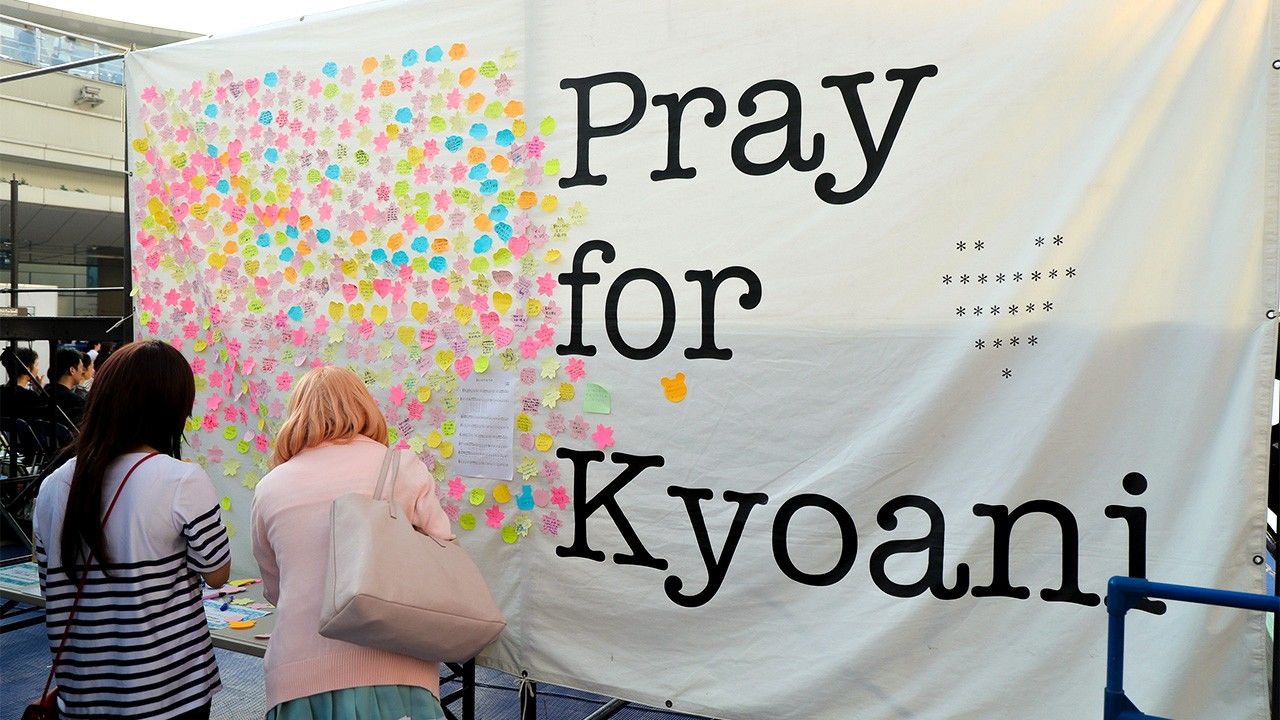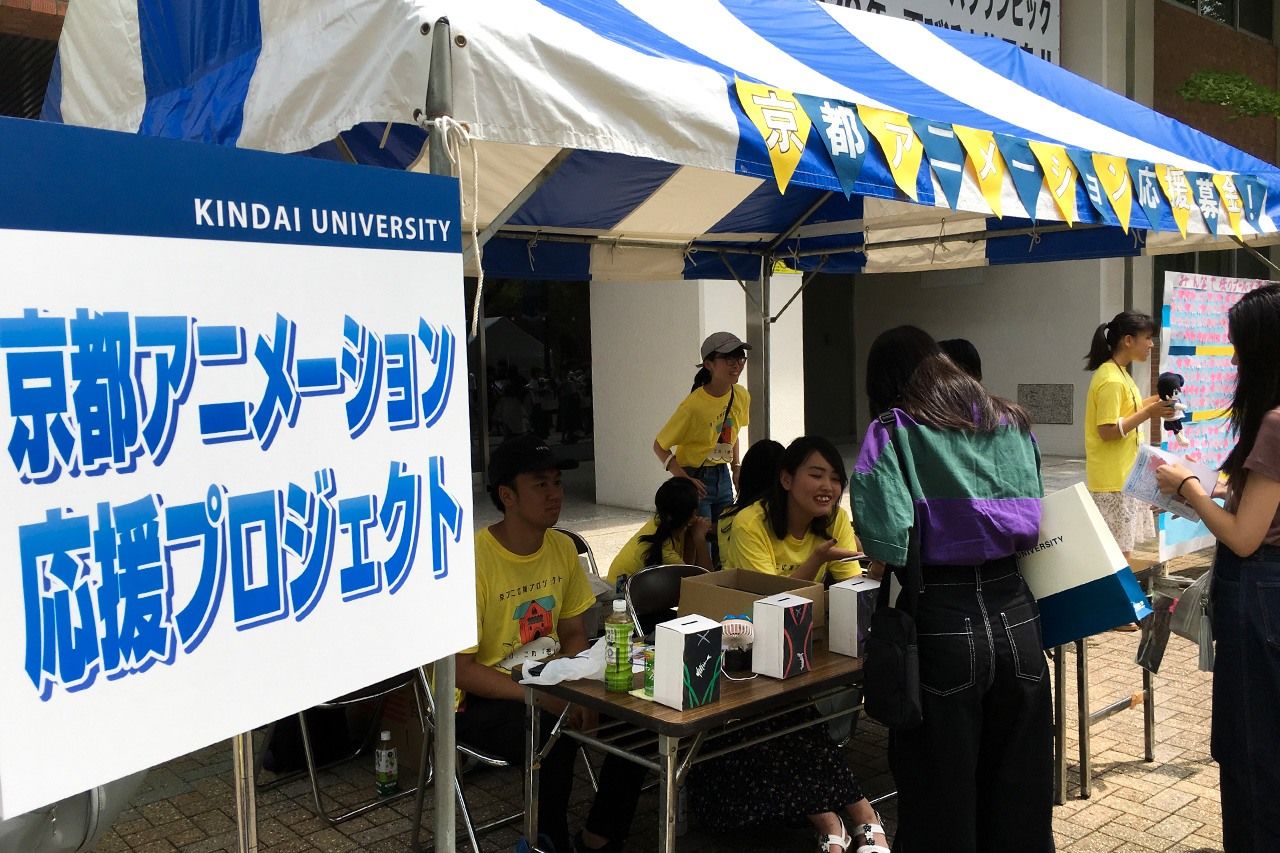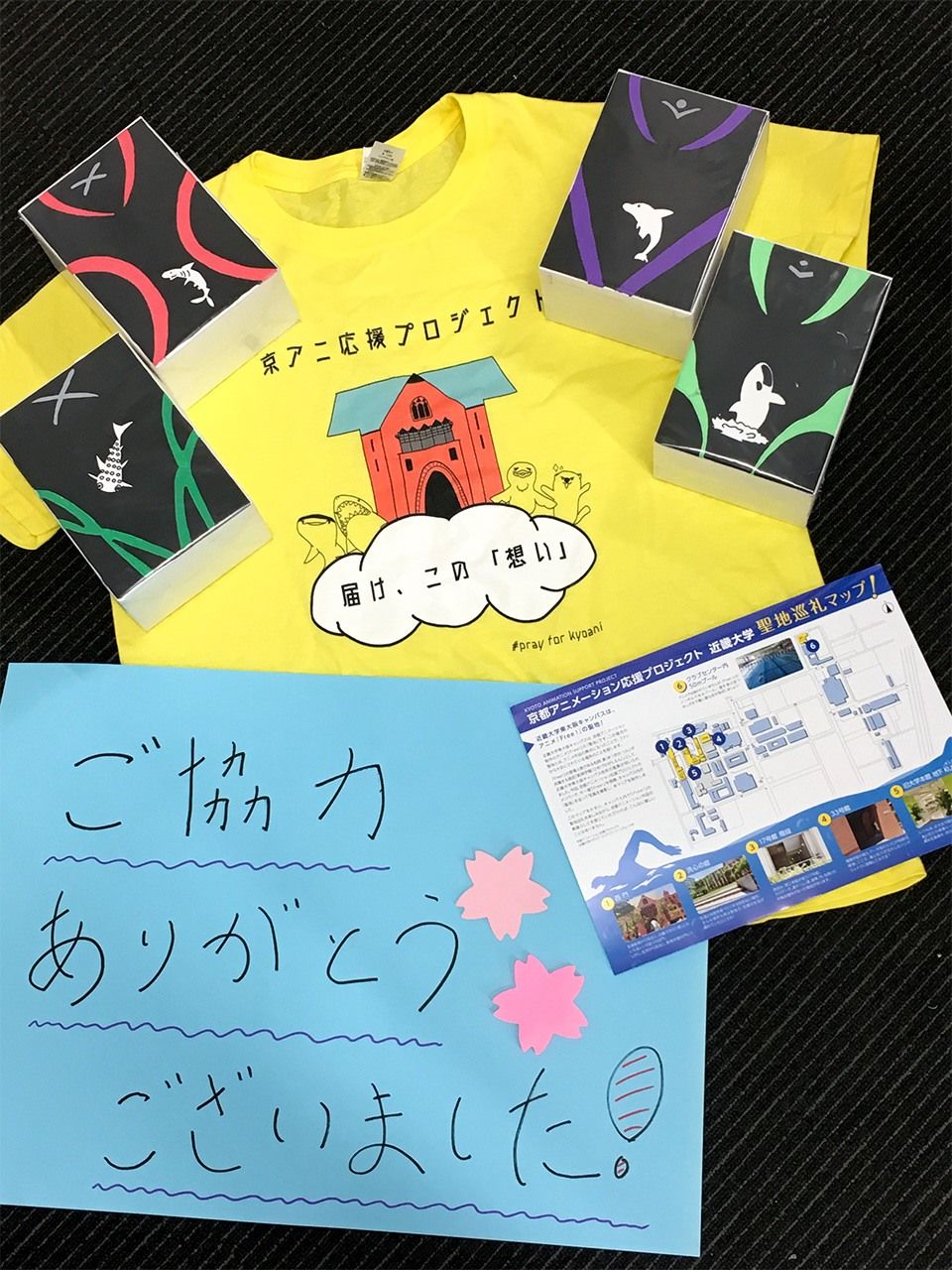
Pilgrims and Prejudice: The Kyoto Animation Arson Attack in the Media
Society Culture Anime- English
- 日本語
- 简体字
- 繁體字
- Français
- Español
- العربية
- Русский
On July 18, 2019, 36 animators and other members of staff at the Kyoto Animation company lost their lives and another 34 were injured, many of them seriously, in an arson attack on the company’s studio in the Fushimi Ward of Kyoto. Before I go any further, I want to acknowledge this terrible loss of life, and express my prayers for a speedy recovery to all those who were injured in the attack.
The man responsible for the tragedy suffered multiple burns himself, and no statement from him has been made public about his actions. Whatever the background to the attack might have been, whatever “motives” he might have had, this was an abhorrent act of senseless murder that deserves the strongest condemnation.
“What Is Kyoto Animation Anyway?”
I have been studying anime and its culture of fandom for many years. In March 2012, I received a doctorate for a dissertation on the subject of “pilgrimages” to places featured in popular anime. When my study was published in September 2018, I wrote a special afterword for the book edition sitting in a McDonald’s just around the corner from the Kyoto Animation studio.
My second book discussed attempts to use tourism and local “branding” to invigorate regional economies. In both these studies, I frequently discussed the phenomenon of fan “pilgrimages” to sites related to anime produced by Kyoto Animation.
Because of this, when the arson attack happened, I found myself swamped with requests from journalists asking for my interpretation of the tragedy. To tell the truth, it was a difficult time. I felt a deep sense of personal shock and grief when I heard what had happened: not just as a researcher, but as a fan myself. But these requests for interviews brought home to me how little awareness or understanding there was of the studio in mainstream society. I often found myself answering basic questions along the lines of “What exactly is Kyoto Animation, anyway?” It seems that the only animation studio that most people might have heard of is Studio Ghibli. So I agreed to speak to the press, on the grounds that someone needed to explain the significance of what had happened. At the same time, I contribute a regular column on media trends to the Mainichi Shimbun newspaper. Even as I found myself quoted as an expert in the news, I spent my time poring over different reports on the incident. Two points stood out in the coverage.
Misunderstandings About the “Pilgrimage” Idea
Several journalists who interviewed me asked me to comment on the “fact” that Kyoto Animation had played a pioneering role in developing the “boom” for anime pilgrimages. I was taken aback by how often people mentioned these pilgrimages as if they were the studio’s main point of significance. When I started my research work in 2008, the concept of anime pilgrimages was not well known. It first came to the attention of the wider general public with the 2016 release of Shinkai Makoto’s megahit Your Name. In 2016, the term “seichi junrei,”—pilgrimages around sites related to anime and other pop culture—was chosen as one of the top 10 Words of the Year. The high profile of the term presumably explained why the media was so eager to use it as a way of getting a handle on the studio and its work.
What I want to make clear, though, is that the idea of pilgrimages was not dreamed up by the anime studios or producers. My book on anime pilgrimages won an award from the Japan Society for Tourism Studies in 2019. One of the reasons, I think, was that the study reveals some of the characteristics of travelers’ behavior in an information society. Anime pilgrimages begin when fans independently seek out the real-world locations that inspired settings in their favorite films or shows and post this information online. Other anime fans use this to visit the places, and post about their experiences. This leads to an accumulation of information based on details discovered and disseminated by travelers, who themselves drive the creation of pilgrimages—not the studios.
Another frequent misunderstanding concerned the way in which the films are made. Many reports claimed that Kyoto Animation was able to handle all the aspects of producing an anime film by itself, from original idea to finished product. It is true that in recent years the studio has solicited ideas for stories from fans, and produced original anime films based on these stories. But the TV anime series that brought the studio to prominence, such as The Melancholy of Haruhi Suzumiya, Lucky Star, K-ON!, and Hyōka were all based on novels or comics published independently of the studio. The budget was raised through the usual “production committee” system, and Kyoto Animation was only responsible for the anime side of the business.
As a consequence, in many cases the studio does not hold rights over the story, and is in no position to promote tourism even if it wanted to. The response of production committees to the idea of anime pilgrimages can differ even among films made by the same studio. Take Lucky Star and K-ON!, for example. In the case of Lucky Star, Kadokawa Shoten, publisher of the original manga and one of the main members of the anime production committee, officially endorsed tourism tie-ins at places like at Kuki and Satte in Saitama, and supports tourism to these popular pilgrimage spots. By contrast, the broadcasting network TBS, which holds the rights to K-ON!, has not officially recognized Toyosatochō in Inukami, Shiga Prefecture, as a pilgrimage site, though it has given the town the right to sell officially licensed merchandise.
It is therefore not correct to claim that Kyoto Animation started the idea of anime pilgrimages, or that it played a pioneering role in the phenomenon. Of course, there is no question that the studio created many of the works that brought the idea to wider prominence among the general public. In addition to the four films I have already mentioned, other series like Tamako Market and Sound! Euphonium have also spurred fans to make pilgrimages, thanks to the outstanding quality of their artwork, characterization, and storylines. But is it really right to pay so much attention to the pilgrimages when discussing the studio? Surely what deserves to be highlighted is the wonderful creative work that has gone into making these films.

In August 2019, a fundraising drive was held at the East Osaka campus of Kindai University, a popular pilgrimage site for fans of the anime Free!
Fanning the Flames of Prejudice Against Anime Fans
Another aspect of the coverage of the incident that made me uncomfortable were the repeated references to the supposed fact that the perpetrator of the attack had himself been on an anime pilgrimage. Several reports used the term “pilgrimage” in reports showing CCTV camera footage of the man apparently visiting locations associated with Kyoto Animation works, in addition to scoping out the studio and its surroundings prior to his attack. But without asking the arsonist himself, it is impossible to know whether he was in fact touring these places on a pilgrimage. The course he followed as it has been published seems to have been quite different from the route followed by most fans. Although he does seem to have visited several places associated with the studio, he also failed to visit several other sites that would usually be considered “must-visit” spots.
Presumably part of the reason so many journalists used the “pilgrimage” term was to save space, rather than stating that the man “seemed to have visited a number of places believed to have inspired the settings in popular anime productions.” But in this context, it carries a serious risk of misunderstanding. As the term “pilgrimage” suggests, the “sacred places” visited have a special significance for anime fans. One of the sites associated with The Melancholy of Haruhi Suzumiya, for example, is a railway station bicycle parking lot. Such places are commonplace throughout Japan, an ordinary part of the everyday urban scenery that would hardly attract attention in normal circumstances. But for fans, it has become a special place, a “sacred spot” worth traveling long distances to see. To speak of an arsonist who willfully destroyed the anime studio and the creative talent who made the anime as having visited such places on a pilgrimage makes no sense.
The emphasis on the arsonist’s having been on a pilgrimage made it seem plausible that he was a passionate anime fan himself. There is a serious risk that this will damage the reputation of anime fans, tarring them all with the same brush. This has happened before. In 1989, a man named Miyazaki Tsutomu abducted and murdered four young girls in Saitama Prefecture. Media coverage of his horrific crimes focused on the killer’s fascination with anime and manga and created a moral panic. Miyazaki became notorious as the “otaku murderer,” encouraging the idea that all anime fans were perverted oddballs who posed a potential threat to society.
Anime fans in Japan have long labored under this prejudice. When a violent crime takes place, the media is apt to fly into a frenzy of excitement if the police emerge from the suspect’s home with a haul of anime, manga, video games, or horror movies. There are breathless reports that “Video game consoles and software were removed from the suspect’s apartment.” What exactly is this supposed to tell us? If you stop to think about it, it is really quite strange. Why do these reports never tell us that the suspect was a keen fisherman or a baseball fan? The emphasis on the pilgrimage aspect of the killer’s behavior made me anxious. It would add insult to injury if media reporting about this tragedy helped to encourage the prejudiced idea that people who take part in anime pilgrimages are themselves a danger to society.
Kyoto Animation and its Emphasis on the Positive Side of Human Nature

Volunteer T-shirt and other items used at the fundraising event at Kindai University. A “pilgrimage map” was handed out to people to donated money.
Over the weekend of August 24–25, student volunteers organized an open fundraising event on the East Osaka campus of Kindai University to support Kyoto Animation. The hastily arranged event drew 620 people over the two days, and raised around ¥420,000. Some people came from as far afield as Tokyo and Nagasaki. The campus itself is a place of pilgrimage for anime fans, having served as the model for the Samezuka Academy in the anime Free! Fans wrote messages of gratitude and encouragement to Kyoto Animation. Some were moved to tears, and others said they had been too upset to visit the studio itself, and were grateful for the opportunity to express what Kyoto Animation meant to them via this place with close associations to the studio.
The works produced by Kyoto Animation are diverse, and it is not easy to sum up their style in just a few words. But one thing they have in common is a realistic depiction of human character and a focus on the positive side of human nature. The tragedy of what happened at Kyoto Animation has been a bitter blow for all those who appreciate the best of what anime can achieve as an art form. The studio’s works did so much to console and encourage so many people. Many of those fans have been moved by the tragedy to help encourage those left behind, as a way of expressing their gratitude and appreciation for everything the studio has done for them. It is to expressions of the positive side of human nature like this that we must look for consolation and hope.
(Originally published in Japanese. Photos courtesy of Okamoto Takeshi. Banner photo: A message board set up at the World Cosplay Summit 2019, where many fans wrote messages of condolence on August 4, 2019, in Higashi-ku, Nagoya. © Jiji).